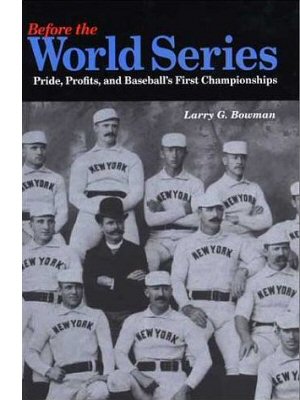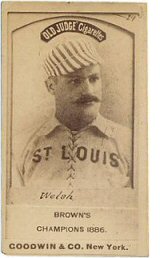4. Book Review: "Before the World Series" by Larry Bowman

The World Series of baseball as we know it today is considered by most researchers to have started in 1903 which marked the beginning of the postseason contests between the National and American Leagues. Postseason matches in the last two decades of the nineteenth century, when they were played, are often thought of today as exhibition games, although the victors in each of these contests could rightfully claim the title of World Champions. In the book Before the World Series, author Larry Bowman describes in detail these early championships and the circumstances that surrounded this tumultuous period of early baseball history.
The book is organized with chapters devoted to each of the postseason matchups throughout the 1880's. With the Introduction and Chapter 1 providing the backdrop for major league baseball organization and events in its formative years, Chapter 2 focuses on interleague play in 1882 and 1883.
The first significant postseason contest detailed in the book, however, was between the National League's Providence Grays and the developing American Association's New York Metropolitans. The three game series was held October 23-25 in the Polo Grounds in New York. As stated in Chapter 3, the games marked the first time in history that the winning teams from two associations met in a formal series to decide the World Championship.
Subsequent chapters of Bowman's book are devoted to postseason contests held in 1885 and 1886 (Chapter 4; both years ended with matches between St. Louis and Chicago), 1887 (Chapter 5; Detroit and St. Louis), 1888 (Chapter 6; New York and St. Louis), 1889 (Chapter 7; New York NL and Brooklyn AA), and 1890 (Chapter 8; Brooklyn and Louisville). Relative to the detail contained in each of these chapters, the Conclusion following Chapter 8 tends to gloss over post season contests of the 1890's, with barely a mention of the important Temple Cup series played each year from 1894 through 1897.
Overall, the book is well researched and documented with footnotes, an extensive bibliography and about twenty well chosen illustrations. It brings to life colorful sports figures from baseball magnates Albert Spalding, Christian Von der Ahe, and Frederick Stearns to legendary Hall of Famers such as Cap Anson, Charles Comiskey and John Montgomery Ward--baseball's first union organizer. The story of Moses Walker, a black major leaguer who played 63 years before Jackie Robinson, sheds light on African Americans' early involvement in baseball.
 The book provides a sound historical perspective for collectors of nineteenth-century baseball cards. Many nineteenth-century card sets include players whose teams are featured within its pages. For example, the "Browns Champions" series within the massive N172 Old Judge Cigarettes set issued between 1887 and 1890 contains players from the 1886 championship team from St. Louis (an example card of Curt Welsh from that Old Judge subset is shown at left).
The book provides a sound historical perspective for collectors of nineteenth-century baseball cards. Many nineteenth-century card sets include players whose teams are featured within its pages. For example, the "Browns Champions" series within the massive N172 Old Judge Cigarettes set issued between 1887 and 1890 contains players from the 1886 championship team from St. Louis (an example card of Curt Welsh from that Old Judge subset is shown at left).
Other card sets with players from 1880's championship teams include the N28 and N29 Allen & Ginter World Champions, N162 Goodwin "Champions," N370 Lone Jack Cigarettes (based on the same player poses as those used in the N172 Old Judge "Brown's Champions" subset) and Lorillard Team Cards, to name just a few.
Before the World Series is available directly from the publisher's website at Northern Illinois University Press, DeKalb, IL 60115. Retail price is $32. The book can also be ordered at discounted prices from Amazon.com.
Sadly, author Larry Bowman passed away in 2002 shortly before his book was released. The book serves as a fitting legacy to him and his research.
5. Clarification (Its the St. Louis Browns!)
In Old Cardboard's April eNewsletter (see OC eNews Issue #36, Item #2), we erroneously identified the team on a newly discovered baseball currency note as the St. Louis Nationals.
Not so.
The ten players on the back of the note were all members of the 1888 St. Louis Browns, a franchise of the American Association. The confusion stems from the title on the front of the woodcut note, which labels the team as part of the "National Base Ball Association."
In fact, the Browns were the only team in the ten-year history of the American Association to win a post-season championship (and therefore the title of World Champions) against their National League counterparts (see Article 4 above).
After the American Association dissolved at the end of the 1891 season, the Browns were absorbed into the National League. Following a couple of name changes at the end of the nineteenth century, the Browns became the St. Louis Cardinals, as we know them today.
Thanks to reader Jonathan Sharkey for helping us to correct this "major faux pas."


